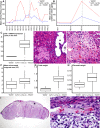Full-length human placental sFlt-1-e15a isoform induces distinct maternal phenotypes of preeclampsia in mice
- PMID: 25860260
- PMCID: PMC4393117
- DOI: 10.1371/journal.pone.0119547
Full-length human placental sFlt-1-e15a isoform induces distinct maternal phenotypes of preeclampsia in mice
Abstract
Objective: Most anti-angiogenic preeclampsia models in rodents utilized the overexpression of a truncated soluble fms-like tyrosine kinase-1 (sFlt-1) not expressed in any species. Other limitations of mouse preeclampsia models included stressful blood pressure measurements and the lack of postpartum monitoring. We aimed to 1) develop a mouse model of preeclampsia by administering the most abundant human placental sFlt-1 isoform (hsFlt-1-e15a) in preeclampsia; 2) determine blood pressures in non-stressed conditions; and 3) develop a survival surgery that enables the collection of fetuses and placentas and postpartum (PP) monitoring.
Methods: Pregnancy status of CD-1 mice was evaluated with high-frequency ultrasound on gestational days (GD) 6 and 7. Telemetry catheters were implanted in the carotid artery on GD7, and their positions were verified by ultrasound on GD13. Mice were injected through tail-vein with adenoviruses expressing hsFlt-1-e15a (n = 11) or green fluorescent protein (GFP; n = 9) on GD8/GD11. Placentas and pups were delivered by cesarean section on GD18 allowing PP monitoring. Urine samples were collected with cystocentesis on GD6/GD7, GD13, GD18, and PPD8, and albumin/creatinine ratios were determined. GFP and hsFlt-1-e15a expression profiles were determined by qRT-PCR. Aortic ring assays were performed to assess the effect of hsFlt-1-e15a on endothelia.
Results: Ultrasound predicted pregnancy on GD7 in 97% of cases. Cesarean section survival rate was 100%. Mean arterial blood pressure was higher in hsFlt-1-e15a-treated than in GFP-treated mice (∆MAP = 13.2 mmHg, p = 0.00107; GD18). Focal glomerular changes were found in hsFlt-1-e15a -treated mice, which had higher urine albumin/creatinine ratios than controls (109.3 ± 51.7 μg/mg vs. 19.3 ± 5.6 μg/mg, p = 4.4 x 10(-2); GD18). Aortic ring assays showed a 46% lesser microvessel outgrowth in hsFlt-1-e15a-treated than in GFP-treated mice (p = 1.2 x 10(-2)). Placental and fetal weights did not differ between the groups. One mouse with liver disease developed early-onset preeclampsia-like symptoms with intrauterine growth restriction (IUGR).
Conclusions: A mouse model of late-onset preeclampsia was developed with the overexpression of hsFlt-1-e15a, verifying the in vivo pathologic effects of this primate-specific, predominant placental sFlt-1 isoform. HsFlt-1-e15a induced early-onset preeclampsia-like symptoms associated with IUGR in a mouse with a liver disease. Our findings support that hsFlt-1-e15a is central to the terminal pathway of preeclampsia, and it can induce the full spectrum of symptoms in this obstetrical syndrome.
Conflict of interest statement
Figures











Similar articles
-
In vivo experiments reveal the good, the bad and the ugly faces of sFlt-1 in pregnancy.PLoS One. 2014 Nov 13;9(11):e110867. doi: 10.1371/journal.pone.0110867. eCollection 2014. PLoS One. 2014. PMID: 25393290 Free PMC article.
-
Placental-Specific sFLT-1 e15a Protein Is Increased in Preeclampsia, Antagonizes Vascular Endothelial Growth Factor Signaling, and Has Antiangiogenic Activity.Hypertension. 2015 Dec;66(6):1251-9. doi: 10.1161/HYPERTENSIONAHA.115.05883. Epub 2015 Sep 28. Hypertension. 2015. PMID: 26416849
-
Maternal plasma concentrations of the placental specific sFLT-1 variant, sFLT-1 e15a, in fetal growth restriction and preeclampsia.J Matern Fetal Neonatal Med. 2017 Mar;30(6):635-639. doi: 10.1080/14767058.2016.1182975. Epub 2016 May 16. J Matern Fetal Neonatal Med. 2017. PMID: 27124553
-
Placental-specific sFLT-1: role in pre-eclamptic pathophysiology and its translational possibilities for clinical prediction and diagnosis.Mol Hum Reprod. 2017 Feb 10;23(2):69-78. doi: 10.1093/molehr/gaw077. Mol Hum Reprod. 2017. PMID: 27986932 Review.
-
Combining Biomarkers to Predict Pregnancy Complications and Redefine Preeclampsia: The Angiogenic-Placental Syndrome.Hypertension. 2020 Apr;75(4):918-926. doi: 10.1161/HYPERTENSIONAHA.119.13763. Epub 2020 Feb 17. Hypertension. 2020. PMID: 32063058 Free PMC article. Review.
Cited by
-
Recent Advances in the Prevention and Screening of Preeclampsia.J Clin Med. 2023 Sep 17;12(18):6020. doi: 10.3390/jcm12186020. J Clin Med. 2023. PMID: 37762960 Free PMC article. Review.
-
Animal Models of Cardiovascular Complications of Pregnancy.Circ Res. 2022 Jun 10;130(12):1763-1779. doi: 10.1161/CIRCRESAHA.122.320395. Epub 2022 Jun 9. Circ Res. 2022. PMID: 35679359 Free PMC article. Review.
-
Genetic predisposition to preeclampsia is conferred by fetal DNA variants near FLT1, a gene involved in the regulation of angiogenesis.Am J Obstet Gynecol. 2018 Feb;218(2):211-218. doi: 10.1016/j.ajog.2017.11.562. Epub 2017 Nov 11. Am J Obstet Gynecol. 2018. PMID: 29138037 Free PMC article. Review.
-
Reliability of Rodent and Rabbit Models in Preeclampsia Research.Int J Mol Sci. 2022 Nov 18;23(22):14344. doi: 10.3390/ijms232214344. Int J Mol Sci. 2022. PMID: 36430816 Free PMC article. Review.
-
Current State of Preeclampsia Mouse Models: Approaches, Relevance, and Standardization.Front Physiol. 2021 Jul 2;12:681632. doi: 10.3389/fphys.2021.681632. eCollection 2021. Front Physiol. 2021. PMID: 34276401 Free PMC article. Review.
References
-
- Saftlas AF, Olson DR, Franks AL, Atrash HK, Pokras R. Epidemiology of preeclampsia and eclampsia in the United States, 1979–1986. Am J Obstet Gynecol. 1990; 163: 460–465. - PubMed
-
- Report of the National High Blood Pressure Education Program Working Group on High Blood Pressure in Pregnancy. Am J Obstet Gynecol. 2000; 183: S1–S22. - PubMed
-
- MacKay AP, Berg CJ, Atrash HK. Pregnancy-related mortality from preeclampsia and eclampsia. Obstet Gynecol. 2001; 97: 533–538. - PubMed
Publication types
MeSH terms
Substances
Grants and funding
LinkOut - more resources
Full Text Sources
Other Literature Sources
Miscellaneous

